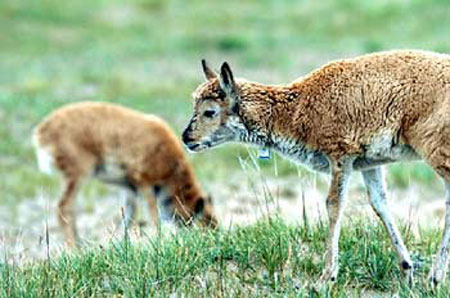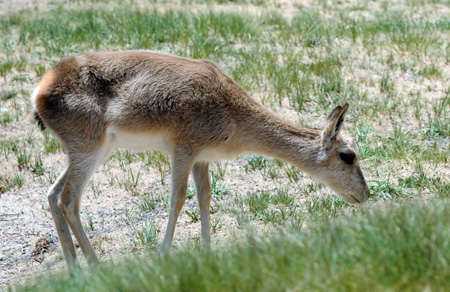China destroys Tibetan antelope hides to show anti-poaching resolution
2009-10-28 17:50 BJT
GOLMUD, Qinghai, Oct. 22 (Xinhua) -- Animal protection authorities in northwest China‘s Qinghai Province Thursday destroyed 2,282 Tibetan antelope hides confiscated from poachers to show resolution against killing of the rare species.
"The hides were seized from poachers over the past ten years," said Cedain Zhou, director of the Hoh Xil Nature Reserve Administration. "We want to show our unswerving attitude in combating poaching."

Two Tibetan antelopes eat grass in the Hoh Xil National Nature Reserve in northwest China‘s Qinghai Province in this file photo taken on July 15, 2005.(Xinhua Photo)
He said the move had been the largest of its kind since 1998 when China began coming down hard on armed poachers in the region.
Over the past decade, more than 4,000 Tibetan antelope skins have been confiscated by the administration.
Tibetan antelopes were targeted by poachers because they produce the finest wool in the world, known as shahtoosh, a Persian word meaning "king of wool".
Each down hair of the Tibetan antelope is around six times thinner than the average human hair.
A shahtoosh shawl, incredibly lightweight and warm, takes the wool from three to four antelopes, and may fetch up to 11,000 U.S. dollars on the global market.
Beginning in the late 1980s, shahtoosh shawls became a high fashion in Europe and the United States which fueled a black market and led to a slump in the population of Tibetan antelopes from 200,000 to 20,000 in 1997.

A Tibetan antelope under state grade 1 protection is seen at a plateau grassland in Hol Xil Nature Reserve, northwest China‘s Qinghai Province, July 30, 2009. (Xinhua/Hou Deqiang)
Although hunting and the selling of Shahtoosh were stringently prohibited, poaching still prevailed in the Hoh Xil.
To curb the rampant slaughter of Tibetan antelopes, and save them from extinction, the Chinese government set up the Hoh Xil Nature Reserve in 1995, and upgraded it to a state-listed reserve in 1997.
The Nature Reserve, in the hinterland of the Qinghai-Tibet Plateau, covers 45,000-sq km with an average altitude of 4,600 meters.
Thanks to the country‘s anti-poaching efforts, no armed poaching has been reported since 2006 in Hoh Xil and the population of Tibetan antelope in this region has grown to around 60,000, Cedain Zhou said.
"As long as the illegal trading and consumption of Tibetan antelope fur exist, there will be a long way ahead in protecting the species," he said.
Tibetan antelopes have been given the highest level of protection under the United Nations‘ Convention on International Trade in Endangered Species since 1979, and listed among the most endangered species by the Chinese government since 1988.
Editor: 卢佳颖 | Source: Xinhua

 Mail
Mail Share
Share Print
Print


 Video
Video









 2009 China Central Television. All Rights Reserved
2009 China Central Television. All Rights Reserved